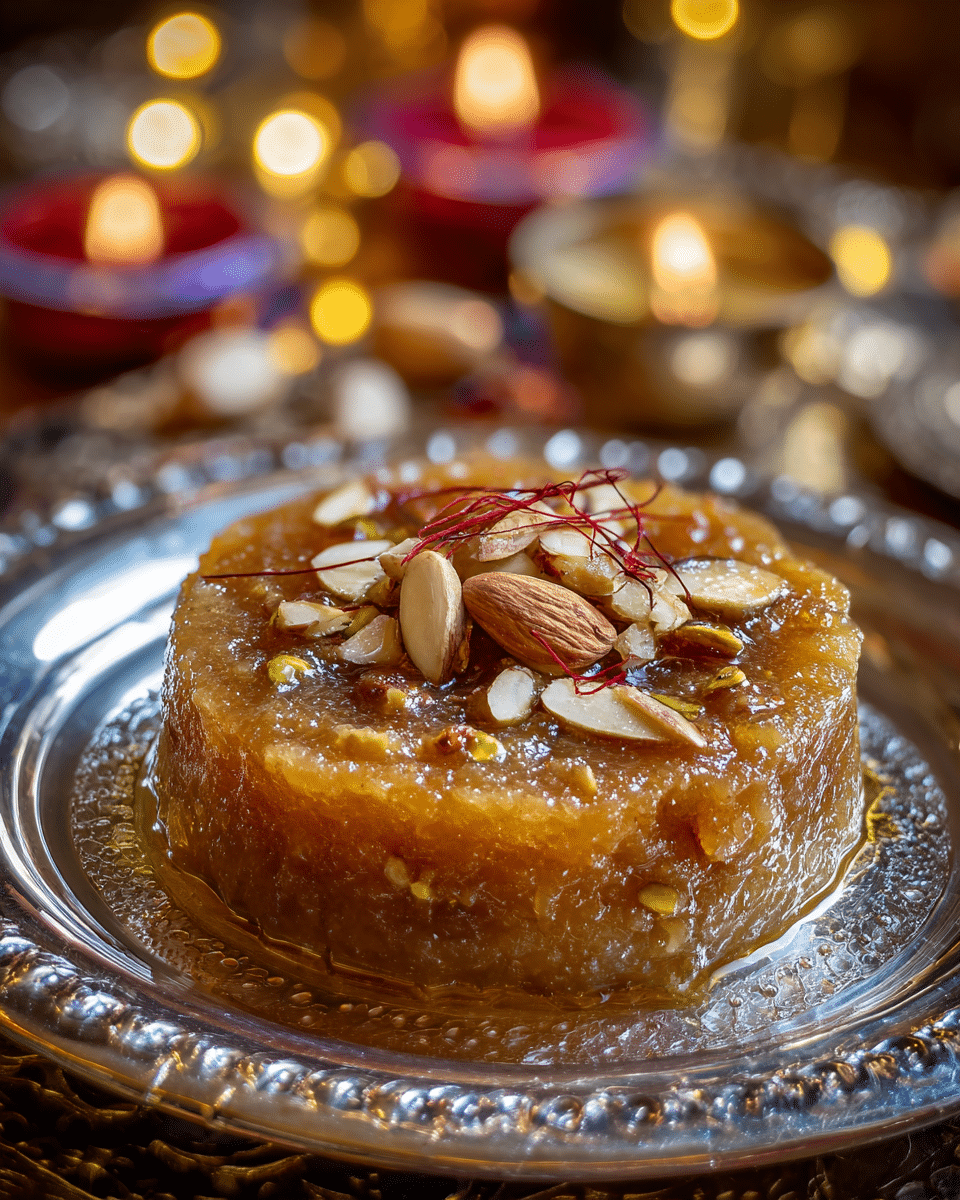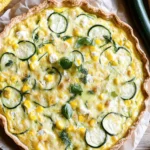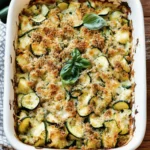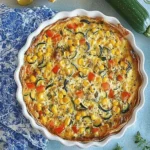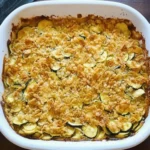Badam Halwa Delight is a luxurious Indian dessert made with blanched almonds, ghee, and sugar, flavored delicately with cardamom and saffron. Traditionally served during festivals and celebrations, this sweet treat is known for its rich, melt-in-the-mouth texture and nutty aroma. Perfectly indulgent and incredibly festive, Badam Halwa is a beloved favorite across generations and a true symbol of Indian culinary decadence.
FULL RECIPE
Ingredients
- 1 cup almonds (badam)
- ½ cup ghee (clarified butter)
- ¾ cup sugar
- 1 cup full-fat milk
- ¼ teaspoon cardamom powder
- A few strands of saffron (optional)
- 2 tablespoons warm milk (for soaking saffron)
- 1 tablespoon chopped pistachios or almonds (for garnish)
Directions
- Soak almonds in hot water for 1 hour or overnight for easier peeling.
- Peel the almonds and blend them into a coarse paste using 1 cup of milk. Do not over-blend into a fine paste; a little graininess gives a better texture.
- Heat 2 tablespoons of ghee in a non-stick pan over low-medium heat.
- Add the almond paste and cook while stirring continuously to avoid sticking.
- As the mixture thickens, add the remaining ghee in parts and keep stirring for 15–20 minutes until it turns golden and releases aroma.
- Stir in the sugar and continue cooking. The halwa will liquefy slightly but will thicken again as it cooks.
- Dissolve saffron in warm milk and add it to the pan along with cardamom powder. Mix well and cook for another 5–7 minutes until the halwa starts leaving the sides of the pan.
- Once the mixture reaches a dense, glossy consistency and begins to clump together, remove from heat.
- Serve hot or warm, garnished with chopped pistachios or almonds.
Nutrition Facts
- Calories: 340 kcal
- Total Fat: 22g
- Saturated Fat: 10g
- Cholesterol: 28mg
- Sodium: 10mg
- Total Carbohydrates: 30g
- Dietary Fiber: 2g
- Sugars: 25g
- Protein: 5g
- Calcium: 70mg
- Iron: 1.2mg
Origin and Cultural Significance
Badam Halwa, a traditional Indian dessert, holds a special place in the culinary heritage of India. It is especially popular in North Indian households and during festive occasions like Diwali, weddings, and religious celebrations. Almonds, or “badam,” have long been prized in Indian cuisine for their nutritional value and luxurious texture, making this halwa a symbol of prosperity and indulgence. The recipe’s roots can be traced back to royal kitchens where rich ingredients like ghee, nuts, and saffron were abundant.
Nutritional Benefits of Almonds
Almonds, the star ingredient in Badam Halwa, are packed with essential nutrients. They are rich in healthy monounsaturated fats, vitamin E, magnesium, and protein. These nutrients contribute to heart health, improved skin quality, and brain function. Despite being calorie-dense, almonds can aid in weight management when eaten in moderation. Incorporating almonds into desserts like halwa offers a delicious way to enjoy these health benefits.
Role of Ghee in Flavor and Texture
Ghee, or clarified butter, is vital in creating the rich, smooth texture and nutty aroma of Badam Halwa. Unlike regular butter, ghee has a higher smoke point and imparts a slightly caramelized flavor that enhances the overall taste. It also helps in binding the almond paste and sugar, giving the halwa its characteristic glossy finish. Additionally, ghee has digestive properties and is considered a healthy fat in Ayurvedic practices.
The Use of Saffron and Cardamom
Saffron and cardamom are traditional spices that elevate the sensory experience of Badam Halwa. Saffron lends a subtle golden hue and a delicate floral aroma, while cardamom adds a warm, citrusy note. These spices not only enhance flavor but also provide antioxidant benefits. Their inclusion transforms a simple nut-based sweet into a sophisticated festive dessert.
Texture and Consistency
One of the defining characteristics of Badam Halwa is its smooth yet slightly grainy texture. This texture results from the way almonds are ground and cooked. The halwa should neither be too runny nor overly dry; it should hold together yet remain soft enough to melt in the mouth. Achieving this balance requires careful cooking and constant stirring to prevent burning while allowing the mixture to thicken perfectly.
Variations of Badam Halwa
Though the traditional recipe is well-loved, several variations exist. Some recipes substitute milk with condensed milk or khoya (reduced milk solids) for a richer, creamier texture. Others may include additional nuts like cashews or pistachios to add crunch and flavor complexity. For a vegan twist, coconut milk can replace dairy milk, and coconut oil can stand in for ghee, though the flavor and texture will vary slightly.
Serving Suggestions and Pairings
Badam Halwa is best served warm to highlight its creamy texture and aromatic spices. It can be enjoyed on its own or paired with other Indian desserts such as gulab jamun or rabri to create a festive dessert platter. For a refreshing contrast, some like to serve it alongside a scoop of vanilla ice cream or a cup of hot chai, which balances the richness of the halwa with a hint of spice.
Storage Tips and Shelf Life
Due to its dairy content, Badam Halwa is best consumed fresh but can be stored in an airtight container in the refrigerator for up to 4-5 days. Before serving, it should be gently reheated on low heat or in a microwave to restore its softness. Freezing is generally not recommended as it can alter the texture. Proper storage ensures the halwa maintains its flavor and moisture without becoming dry or hard.
Health Considerations
While Badam Halwa is nutrient-rich, it is also calorie-dense and high in sugar and fat. People monitoring their sugar intake or those with diabetes should consume it in moderation. However, the presence of almonds and ghee, both considered beneficial fats, can make this dessert a relatively healthier option compared to others made with refined flours and artificial additives.
Popular Occasions for Serving Badam Halwa
Badam Halwa is often prepared during special occasions such as religious festivals, weddings, and family celebrations. It is considered an auspicious dessert and is frequently offered as prasad (a religious offering) in temples. Its rich ingredients and labor-intensive preparation make it a treat reserved for meaningful moments rather than everyday consumption.
Conclusion
Badam Halwa Delight is more than just a sweet dish; it is a celebration of tradition, flavor, and nutrition. Combining the richness of almonds and ghee with fragrant spices, it offers a decadent experience that connects people to their cultural roots. Whether enjoyed during festivals or as a special treat, this dessert continues to charm food lovers with its luxurious texture and timeless appeal. Its versatility and health benefits, when eaten mindfully, make it a cherished recipe passed down through generations.

